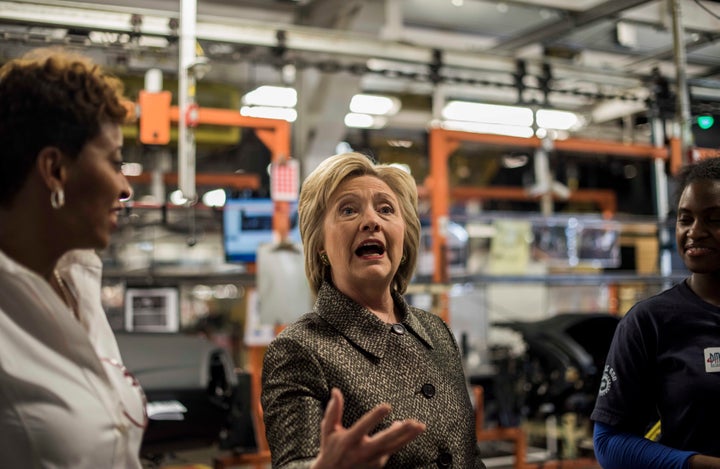DETROIT ― Elizabeth Warren took her presidential campaign to the Midwest this week, starting with two stops in Michigan where she unveiled a $2 trillion “green manufacturing” proposal. The choice of locale had little to do with state’s Democratic primary, which comes well into the cycle on March 10, and everything to do with symbolism.
Michigan is among the politically critical states Donald Trump won narrowly in 2016. This was Warren’s way of saying that she can win there by seizing one of his signature issues: bringing factory jobs back to the U.S.
The Massachusetts senator has been doing a lot of that lately. She rolled out her opioid plan in West Virginia and Ohio, two states ravaged by the epidemic, and introduced a plan to protect public lands during a swing through Colorado and Utah. When it was time to sketch out a scheme to increase affordable housing, Warren toured low-income neighborhoods in Alabama, Mississippi and Tennessee.
These trips have organizing value, especially because of Warren’s now-famous “selfie lines,” where she offers a photo to anybody willing to wait. (Just think of all the images bouncing around on social media pages.) But it’s the attention these trips generate for her policies, not the pictures, that best explains why Warren has been gaining ground.

It wasn’t so long ago that the professional political class was ready to dismiss her. She couldn’t shake the controversy over her statements about Native American heritage and, despite being well-known and beloved on the activist left, her poll numbers dipped ― relegating her to the middle of the second tier, with a bunch of other candidates looking up at Vermont Sen. Bernie Sanders and former Vice President Joe Biden.
Now she has been on the cover of Time magazine and her poll numbers are on the rise. Although she remains well behind the front-runners, a recent Economist/YouGov survey found 42% of Democratic voters were at least considering Warren for the primaries. It was the second highest of any Democrat, just behind Biden and just ahead of Sanders. (Over the weekend, a new Iowa poll produced strikingly similar results.) At this early stage of the primary campaign, with so many voters still tuning in for the first time, that means a lot.
But it is one thing to climb back into the Democratic race and quite another to win it, to say nothing of prevailing in November. And there are reasons to wonder just how far policy can take Warren, starting with what happened to the last brainy presidential candidate who ran on an ambitious, detailed campaign agenda. Warren’s mantra is “I have a plan for that,” but Hillary Clinton had plenty of plans too. In 2016, she still came up short in the Electoral College.
Warren, though, is not Hillary. In fact, her approach to policy is more reminiscent of the other Clinton, Bill, back when he first ran for president in 1992.
In the run-up to that election, Bill more or less invented the modern version of campaigning on policy, eventually publishing a book, “Putting People First,” that turned into a governing blueprint for his first years in office. As president, he became famous for policy-laden State of the Union speeches that consistently bored pundits and impressed the public, buoying him in moments of political peril.
The idea that Warren has more in common with Bill than Hillary might seem odd, given that Warren’s unabashedly liberal agenda is an explicit rejection of the Democrats’ governing philosophy in the 1990s ― one that was openly apologetic about big government, relied heavily on free trade and free markets, and led to the regulatory changes in banking that first attracted Warren’s ire and pushed her into politics.
But on bread-and-butter issues, Bill in 1992 ran a thematically populist campaign that worked because of how it fit together, who he was, and the kind of leadership he was proposing to unseat.
In other words, he had a coherent, credible story to tell. Warren does too.
Why Policy Talk Works For Warren
That story starts with Warren’s upbringing in Oklahoma, in a family that sometimes faced financial difficulty, especially after her father, who had juggled a series of blue-collar jobs, had to stop working because of a heart attack.
It is not a story of overcoming extraordinary struggle. It is a story of overcoming ordinary struggle, like losing the family station wagon, punctuated by occasional crises and bad decisions, like the time Warren left college early in order to marry a man she would later divorce.
The bemused, sardonic way she reminisces about that episode ― “you know it’s a problem when you have to refer to the husbands by their number” ― probably rings true to the tens of millions of Americans who have gone through divorce, or at the very least a large portion of the women among them.
These recollections, so well known to reporters and followers but still new to most Americans, do more than establish a connection with potential voters. They give Warren a natural platform for talking about policy, because she can attest personally to the importance of things like a high minimum wage (which is what her mom got when she was supporting the family), strong unions (which is how her brother got his pension), and cheap community colleges (which is how she eventually got her degree).

Maybe the best known of these is the story she tells about her experience as a working mother, sobbing because she couldn’t find decent child care and was preparing to quit her job, until her Aunt Bee saved her by moving in and taking care of the kids. “If everybody in the world had an Aunt Bee, we’d all be fine,” Warren said during an MSNBC town hall in Fort Wayne, Indiana, the day after her Michigan tour. “But they don’t.” Then Warren pivoted to her child care plan, which she says will guarantee affordable, quality care for all families with kids.
One risk of proposing so many policies is that they come to seem scattershot, so that the whole ends up being a lot less than the sum of the parts. Warren has managed to avoid this so far, in part because she’s got such a clear, strong overarching message to her campaign ― that she is fighting to make sure government is on the side of low- and middle-income Americans, not the wealthy and powerful corporations out to exploit them.
It’s a familiar trope that works best with a foil. Bill Clinton in 1992 had the advantage of running against a patrician, seemingly aloof George H.W. Bush in the middle of a recession. Hillary had a much tougher time because she was running against Trump, who promised, as she did, to protect working-class Americans. Trump had a very specific kind of working-class American in mind, namely the white kind, but he made enough promises ― like great health care for everyone ― to undermine Hillary’s claim to the populist mantle.
Warren has the luxury of running against a different version of Trump, one that still talks like a populist but has the governing record of a plutocrat. He gave huge tax cuts to the rich. He made it easier for corporations to take jobs offshore. He tried to take health insurance away from tens of millions of people. He’s knee-deep in corruption.
Of course every Democrat can (and does) make these attacks. Warren has the credibility of somebody whose political career started as a crusader against greedy, corrupt banks.
And then there are the plans.
Why Policy Talk Makes Warren A Target
It’s obvious from the details of her proposals that she’s consulted widely with experts and has thought through some of the tougher design questions, like how you actually make sure there are enough new child care providers and that they will be good at what they do.
Much of this necessarily goes beyond what even most politically engaged voters grasp. That may not matter. At the Detroit rally, a working mother named Hallie Bard, from the suburb of Farmington, talked about how much Warren’s child care plan meant to her, even though she didn’t know much about how the plan would actually work.
“I have been dealing with this for 15 years,” Bard said. “It has prohibited me from taking jobs occasionally, because my entire check would go to child care and I am not about to underpay someone to care for the most important people in my life. … It’s important to me that she gets it, that she understands there needs to be a dedication to that.”
But as the campaign moves forward, not everyone will take to Warren or her agenda so kindly. There will be philosophical objections from conservatives wary of what would likely be the largest expansion of government in half a century. There will also be more practical objections, some outlandish and some not.
Her wealth tax would apply to only the very richest Americans, even though Republicans are sure to imply otherwise when they attack it as a big tax hike. But it could genuinely be difficult to enforce ― and, without the big sums she envisions it collecting, financing all of those great-sounding initiatives on education and health care gets more complicated.

This is just one big danger of proposing so many policies: It creates so many targets for opponents to attack. Another is feasibility. She’s one of the few Democrats who has called for ending the filibuster, which would stop a progressive agenda cold even if Democrats take the Senate. But she is also calling for a constitutional amendment guaranteeing a right to vote and overturning Citizen United ― steps that, however advisable, aren’t happening anytime soon.
And that's to say nothing of the formidable political hurdles Warren still faces, starting but not ending with the fact that a large number of Americans still have issues with women who have brains or ambition or, heaven forbid, both. That was trouble for Hillary Clinton and will just as surely be trouble for Warren too.
It’s a good sign for Warren that she’s drawing healthy crowds: 500 in Detroit and 1,700 in Lansing, her campaign said. But both were overwhelmingly white, even though Detroit is the blackest city in America. It’s just one reminder that she draws support heavily from college-educated, white liberal voters ― an important constituency in the Democratic Party, for sure, but hardly enough to secure the nomination.
Warren has time, however, and under the right circumstances policy really can be a strong political asset. Years ago, in the middle of yet another Democratic presidential campaign, Mark Schmitt of the New America Foundation observed, “It’s not what you say about the issues, it’s what the issues say about you.” Right now, the issues say Warren knows who she is and what she wants to do. A pitch like that could take her far.
